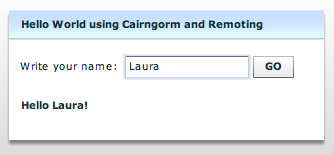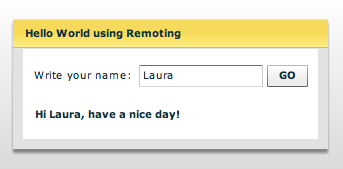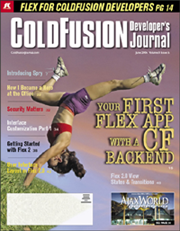Flash Remoting
Hello World Cairngorm example
 A couple of months ago, we posted an updated version of a Hello World Flex example. We have created the same example, but using the Cairngorm framework. It still uses Remoting and ColdFusion. It is simple, but I think that by being so simple, it is easier to follow than a full-fledge application. It shows most of the pieces that make up a Cairngorm application, such as the ModelLocator to store the data and the state of the application, the controller, the command, the services and the delegate.
A couple of months ago, we posted an updated version of a Hello World Flex example. We have created the same example, but using the Cairngorm framework. It still uses Remoting and ColdFusion. It is simple, but I think that by being so simple, it is easier to follow than a full-fledge application. It shows most of the pieces that make up a Cairngorm application, such as the ModelLocator to store the data and the state of the application, the controller, the command, the services and the delegate.
Disclaimer: We do not usually use Cairngorm, so this is only our interpretation of how a Cairngorm app would look like (we use Mate for our Flex development).
IFBIN Flex-ColdFusion example updated
 When we submitted our Flex-ColdFusion example to IFBIN, Flex was in an early beta, which means that the example doesn't work with the final release.
When we submitted our Flex-ColdFusion example to IFBIN, Flex was in an early beta, which means that the example doesn't work with the final release.
CFDJ article: Your First Flex Application with a ColdFusion Backend
 Our Flex "My To-Do List" tutorial has been published in the June issue of the ColdFusion Developer's Journal (and we made the front page!). It can be read online and the source can be found at the project page.
Our Flex "My To-Do List" tutorial has been published in the June issue of the ColdFusion Developer's Journal (and we made the front page!). It can be read online and the source can be found at the project page.
Although simple, we tried to be as complete as possible for "your first Flex app". It shows how to use the CF wizards, use events, create custom components and use the RemoteObject tag to send and retrieve data from the server.
Our Flex Developer Derby entries
We submitted two entries for the Flex Developer Derby, which, for some reason, are not yet posted at Adobe Labs.
Home Locator is a complete revamp of our Real Estate sample application. We changed the functionality and included a Yahoo! Map that shows the property location. We actually didn't use much of the old code and we focused much more on the usability and look and feel of the application. We spent an incredible amount of time during the design, not even doing actual code. Most of the hurdles we encountered were due to Yahoo! maps not wanting to behave and bugs in the Flex framework, specially when we wanted to skin the application, going away from the default halo (or whatever is called now) look. At the end, we are happy with the outcome. Before you ask, no, we are not planning to give the source away, at least not for now. We are, however, going to post the source for the original Real Estate application for the Beta 3 release.
We have no hopes of winning anything with the other application, My to-do list, since it does not compare to the other entries. It is really a very simple application, and it was developed as part of an article for the ColdFusion Developer Journal. So you can expect to see a step-by-step tutorial based on it and the complete source for download soon.
ColdFusion Flash Forms Macromedia Developer Center article - Part 2
We've had very good feedback from the first part of the ColdFusion Flash Forms article published at Macromedia. Thank you!
Many of you have asked when the second part is going to be published. The answer is: soon! But some readers have asked Macromedia and us to be able to see it sooner. So we decided to post it here for download until it is finally published at the Macromedia Developer Center.
Enjoy!
Update: The article has been published by Adobe, so these are the new links
The Real Estate Sample Application - Part 2: Managing Property Listings through Flash Forms
Sample files
Live example
Related posts: ColdFusion Flash Forms Macromedia Developer Center article - Part 1
ColdFusion Flash Forms Macromedia Developer Center article
We are happy to announce that the first part of a series of two articles, "The Real Estate Sample Application - Part 1: Building the Search Functionality", has been published at the Macromedia Developer Center. It's a walk through a Flash Forms sample application that uses Flash Remoting. You can view it running here. Before anyone asks, this is the almost-finished application, so it contains features not explained in the article and downloadable code. You will need to wait until the second part for that.
As always, you are welcomed to comment about it or ask any question here.
The Real Estate Sample Application – Part 1: Building the Search Functionality
Consuming a Web Service through Flash Remoting and CFForm
One of the lesser-known features of the Flash Remoting gateway is to act as a proxy to a web service. Using this proxy, you can effectively circumvent the cross-domain restrictions in the flash player, as all calls are local to the flash movie.
It turns out to be very easy to make the call. It is almost exactly the same as calling a local CFC
How to transfer data with Flash Remoting
In the Introduction to Flash Remoting post, I explained how to connect to a Flash Remoting gateway. I believe that the most difficult part when using Remoting, however, is knowing how to manage the transfer of data from and to the server. This transfer happens when Flash makes a call to a service and sends parameters, and when the server sends a response (not a void function). I will first briefly explain how to send and receive any type of data and then go through all the data types available and show you how to handle them.
Introduction to Flash Remoting
From our current poll on your opinion about Flash Remoting with CFForm, it is clear that most of our readers are excited about it. There are others, however, that either find it too complex or do not know what Remoting is.
I will try to help both groups by explaining what Remoting is and how it can be used.
Custom CFTree icons
![]() Have you ever wondered if it was possible to change the folder icons in the Flash version of cftree? The answer is yes, with a little of workaround.
Have you ever wondered if it was possible to change the folder icons in the Flash version of cftree? The answer is yes, with a little of workaround.
This example will show you how to change the opened/closed folder icon, the leaf icon, the icon of a specific node, and the default triangles that open and close nodes. Because we need to set the default values before the data is loaded, we cannot change the icons of an already loaded cftee, unless we change each of the nodes one by one.
MXNA Reader built with CFForms
We made a Reader for MXNA in ColdFusion using only Flash Forms. But wait, it's not only an MXNA Reader, you can also read Full As A Goog :)
You can jump to see the application or continue reading the details. (A screen shot in case your screen resolution is less than 1024x768)



